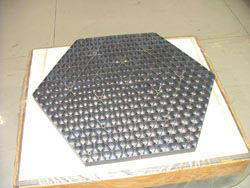Imagine the Universe News - 03 May 2007
New Technologies for James Webb Space Telescope Approved Early
| 03 May 2007 |

|
| This is one mirror segment. 18 mirror segments will form a single large mirror with a total area of 25 square-meters (almost 30 square yards) when they come together. Credit: NASA |
More than a year ahead of schedule, a team of independent experts has approved all ten new technologies developed for NASA's James Webb Space Telescope. Many of the technologies are revolutionary and have never before been used on any satellite or space telescope. The early approval can reduce the risk of increased costs and schedule delays before the program is approved for further development.
NASA commissioned the team of engineers, scientists and project managers to conduct the technical review. The group evaluated the telescope's near and mid-infrared detectors, sunshield materials, lightweight cryogenic mirrors, microshutter arrays, cryogenic detector readout application-specific integrated circuits, cryogenic heat switches, a large precision cryogenic structure, a cryocooler for the mid-infrared instrument, and wavefront sensing and control. They determined the technologies were tested successfully in a space-like environment and are mature enough to include on the telescope's upcoming mission.
The actual hardware and software that will fly on the telescope now can be engineered from working prototypes. These technologies will allow the observatory to peer back in time to about 400 million years after the Big Bang, enabling scientists to study the first generation of stars and galaxies.
"The technology non-advocate review was our attempt to address one common problem that NASA missions encounter that leads to cost growth," said Eric Smith, Webb program scientist at NASA Headquarters, Washington. "That problem is late maturation of technology in a program's life-cycle. By conducting an external review of our technologies more than a year ahead of the Preliminary Design Review - when they are traditionally examined - we hope to better manage that aspect of the program's costs."
Two examples of the new technologies are the microshutter arrays and wavefront sensing and control.

|
| The wavefront sensing and control system calculates the mirror adjustments required to bring an image into focus. Ball Aerospace engineered a scaled telescope testbed, shown here, so that wavefront sensing and control can be developed and tested. Credit: NASA |
Microshutters are tiny doorways, the width of a few hairs, that will allow scientists to remotely and systematically block out unwanted light and view the most distant stars and galaxies ever seen. The telescope will be the first project to employ this technology.
Through a process called wavefront sensing and control (a set of algorithms and software programs), the optimum position of each of the telescope mirrors will be computed, and the positions will be adjusted as necessary, causing the individual mirrors to function as one very sensitive telescope.
"At the inception of the James Webb Space Telescope program, NASA adopted a strategy of making significant, early investments in the development of the diverse and challenging new technologies needed to conduct the mission," said Phil Sabelhaus, project manager at Goddard. "Receiving the review board's confirmation that we have met the goal more than a year early for all of our new technologies is a major accomplishment for our team and a tribute to the benefits of the early investment strategy," Sabelhaus said.
The James Webb Space Telescope is expected to launch in 2013. The telescope is a joint project of NASA, the European Space Agency and the Canadian Space Agency.



